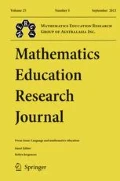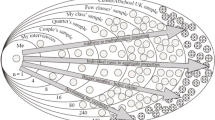Abstract
Although sampling has been mentioned as part of the chance and data component of the mathematics curriculum since about 1990, little research attention has been aimed specifically at school students’ understanding of this descriptive area. This study considers the initial understanding of bias in sampling by 639 students in grades 3, 5, 7, and 9. Three hundred and forty-one of these students then undertook a series of lessons on chance and data with an emphasis on chance, data handling, sampling, and variation. A post-test was administered to 285 of these students and two years later all available students from the original group (328) were again tested. This study considers the initial level of understanding of students, the nature of the lessons undertaken at each grade level, the post-instruction performance of those who undertook lessons, and the longitudinal performance after two years of all available students. Overall instruction was associated with improved performance, which was retained over two years but there was little difference between those who had or had not experienced instruction. Results for specific grades, some of which went against the overall trend are discussed, as well as educational implications for the teaching of sampling across the years of schooling based on the classroom observations and the changes observed.
Similar content being viewed by others
References
Australian Education Council. (1991).A national statement on mathematics for Australian schools. Melbourne: Curriculum Corporation.
Bernstein, P. L. (1998).Against the gods: The remarkable story of risk. New York: Wiley.
Bright, G. W., Harvey, J. G., & Wheeler, M. M. (1981). Fair games, unfair games. In A. P. Shulte & J. R. Smart (Eds.),Teaching statistics and probability: 1981 Yearbook (pp. 49–59). Reston, VA: National Council of Teachers of Mathematics.
Callingham, R., & McIntosh, A. (2002). Mental computation competence across years 3 to 10. In B. Barton, K. C. Irwin, M. Pfannkuch & M. O. J. Thomas (Eds.),Mathematics education in the South Pacific (Proceedings of the 25th annual conference of the Mathematics Education Research Group of Australasia, Auckland, Vol 1, pp. 155–163). Sydney: MERGA.
Cohen, J. (1969).Statistical power analysis for the behavioural sciences. New York: Academic Press.
Estepa, A., Batanero, C., & Sanchez, F. T. (1999). Students’ intuitive strategies in judging association when comparing two samples.Hiroshima Journal of Mathematics Education, 7, 17–30.
Evans, J. St. B. T., & Dusoir, A. E. (1977). Proportionality and sample size as factors in intuitive statistical judgement.Acta Psychologica, 41, 129–137.
Fischbein, E., & Schnarch, D. (1997). The evolution with age of probabilistic, intuitively based misconceptions.Journal for Research in Mathematics Education, 28, 96–105.
Gal, I. (2002). Adults’ statistical literacy: Meanings, components, responsibilities.International Statistical Review, 70, 1–51.
Gigerenzer, G., & Hoffrage, U. (1995). How to improve Bayesian reasoning without instruction: Frequency formats.Psychological Review, 102, 684–704.
Helme, S., & Stacey, K. (2000). Improving decimal understanding: Can targeted resources make a difference? In J. Bana & A. Chapman (Eds.),Mathematics education beyond 2000 (Proceedings of the 23rd annual conference of the Mathematics Education Research Group of Australasia, Vol. 1, pp. 299–306). Perth, WA: MERGA.
Hill, P. W., Rowe, K. J., Holmes-Smith, P., & Russell, V. J. (1996).The Victorian Quality Schools Project: A study of school and teacher effectiveness. Report (Volume 1). Melbourne: Centre for Applied Educational Research, University of Melbourne.
Izard, J. F. (2004, March).Best practice in assessment for learning. Paper presented at the Third Conference of the Association of Commonwealth Examinations and Accreditation Bodies onRedefining the Roles of Educational Assessment, South Pacific Board for Educational Assessment, Nadi, Fiji.
Jacobs, V. R. (1997, March).Children’s understanding of sampling in surveys. Paper presented at the annual meeting of the American Educational Research Association, Chicago.
Jacobs, V. R. (1999). How do students think about statistical sampling before instruction?Mathematics in the Middle School, 5(4), 240–263.
Kahneman, D., & Tversky, A. (1972). Subjective probability: A judgement of representativeness.Cognitive Psychology, 3, 430–454.
Lane, D. M. (2003). Hyperstat on-line textbook. Retrieved October 21, 2004, from http://davidmlane.com/hyperstat/index.html
Lappan, G., Fey, J. T., Fitzgerald, W. M., Friel, S. N., & Phillips, E. D. (1998).Samples and populations. Menlo Park, CA: Dale Seymour Publications.
Lovitt, C., & Lowe, I. (1993).Chance and data investigations (Vols. 1–2). Melbourne: Curriculum Corporation.
Madison, B. L., & Steen, L. A. (Eds.). (2003).Quantitative literacy: Why numeracy matters for schools and colleges. Princeton, NJ: The National Council on Education and the Disciplines.
Metz, K. E. (1999). Why sampling works or why it can’t: Ideas of young children engaged in research of their own design. In F. Hitt & M. Santos (Eds.),Proceedings of the 21st Annual Meeting of the North American Chapter of the International Group for the Psychology of Mathematics Education (Vol. 2, pp. 492–499). Cuernavaca, Mexico: PMENA.
Metz, K. E. (2004). Children’s understanding of scientific inquiry: Their conceptualisation of uncertainty in investigations of their own design.Cognition and Instruction, 22(2), 219–290.
Mokros, J., & Russell, S. J. (1995). Children’s concepts of average and representativeness.Journal for Research in Mathematics Education, 26(1), 20–39.
National Council of Teachers of Mathematics. (1989).Curriculum and evaluation standards for school mathematics. Reston, VA: Author.
Pegg, J. E. (2002). Assessment in mathematics: A developmental approach. In J. M. Royer (Ed.),Mathematical cognition (pp. 227–259). Greenwich, CT: Information Age Publishing.
Reading, C., & Shaughnessy, M. (2000). Student perceptions of variation in a sampling situation. In T. Nakahara & M. Koyama (Eds.),Proceedings of the 24th Conference of the International Group for the Psychology of Mathematics Education (Vol. 4, pp. 89–96). Hiroshima, Japan: Hiroshima University.
Rubin, A., Bruce, B., & Tenney, Y. (1991). Learning about sampling: Trouble at the core of statistics. In D. Vere-Jones (Ed.),Proceedings of the Third International Conference on Teaching Statistics (Vol. 1, pp. 314–319). Voorburg, The Netherlands: International Statistical Institute.
Rubin, A., & Mokros, J. (1990).Data: Kids, cats, and ads: Statistics. Menlo Park, CA: Dale Seymour Publications.
Saldanha, L., & Thompson, P. (2002). Conceptions of sample and their relationship to statistical inference.Educational Studies in Mathematics, 51, 257–270.
Salsburg, D. (2001).The lady tasting tea: How statistics revolutionized science in the twentieth century. New York: Henry Holt.
Schwartz, D. L., Goldman, S. R., Vye, N. J., Barron, B. J., & The Cognition and Technology Group at Vanderbilt. (1998). Aligning everyday and mathematical reasoning: The case of sampling assumptions. In S. P. Lajoie (Ed.),Reflections on statistics: Learning, teaching and assessment in grades K-12 (pp. 233–273). Mahwah, NJ: Lawrence Erlbaum.
Torok, R. (2000). Putting the variation into chance and data.Australian Mathematics Teacher, 56(2), 25–31.
Tversky, A., & Kahneman, D. (1971). Belief in the law of small numbers.Psychological Bulletin, 76(2), 105–110.
Wagner, D. A., & Gal, I. (1991).Project STARC: Acquisition of statistical reasoning in children. (Annual Report Year 1). Philadelphia, PA: University of Pennsylvania, Literacy Research Center.
Watson, J. M. (1997). Assessing statistical literacy using the media. In I. Gal & J. B. Garfield (Eds.),The assessment challenge in statistics education (pp. 107–121). Amsterdam: IOS Press and The International Statistical Institute.
Watson, J. M. (2000). Statistics in context.Mathematics Teacher, 93, 54–58.
Watson, J. M. (2002a). Lessons from variation research II: For the classroom. In M. Goos & T. Spencer (Eds.),Mathematics — making waves (Proceedings of the Nineteenth Biennial Conference of the Australian Association of Mathematics Teachers Inc., Brisbane, pp. 424–432). Adelaide: AAMT Inc.
Watson, J. M. (2002b). When 2 + 2 ≠ 4 and 6 + 6 ≠ 12 in data and chance.New England Mathematics Journal, 34(2), 56–68.
Watson, J. M. (2004). Developing reasoning about samples. In D. Ben-Zvi & J. Garfield (Eds.),The challenge of developing statistical literacy, reasoning and thinking (pp. 277–294). Dordrecht, The Netherlands: Kluwer.
Watson, J. M., & Kelly, B. A. (2002a). Can grade 3 students learn about variation? In B. Phillips (Ed.),CD of the Proceedings of the Sixth International Conference on Teaching Statistics: Developing a statistically literate society, Cape Town, South Africa. Voorburg, The Netherlands: International Statistical Institute.
Watson, J. M., & Kelly, B. A. (2002b). Grade 5 students’ appreciation of variation. In A. Cockburn & E. Nardi (Eds.),Proceedings of the 26th Conference of the International Group for the Psychology of Mathematics Education (Vol. 4, pp. 385–392). Norwich, UK: University of East Anglia.
Watson, J. M., & Kelly, B. A. (2002c). Variation as part of chance and data in grades 7 and 9. In B. Barton, K. C. Irwin, M. Pfannkuch, & M. O. J. Thomas (Eds.),Mathematics education in the South Pacific (Proceedings of the 26th annual conference of the Mathematics Education Research Group of Australasia, Auckland, Vol. 2, pp. 682–689). Sydney: MERGA.
Watson, J. M., & Kelly, B. A. (2003, December).The vocabulary of statistical literacy. Refereed paper presented at the joint conferences of the New Zealand Association for Research in Education and the Australian Association for Research in Education , Auckland, New Zealand. Retrieved March 20, 2005 from http://www.aare.edu.au/03pap/wat03297.pdf
Watson, J. M., & Kelly, B. A. (2004). A two-year study of students’ appreciation of variation in the chance and data curriculum. In I. Putt, R. Faragher, & M. McLean (Eds.),Mathematics education for the third millennium: Towards 2010 (Proceedings of the 27th Annual Conference of the Mathematics Education Research Group of Australasia, Townsville, Vol. 2, pp. 581–588). Sydney: MERGA.
Watson, J. M., Kelly, B. A., Callingham, R. A., & Shaughnessy, J. M. (2003). The measurement of school students’ understanding of statistical variation.International Journal of Mathematical Education in Science and Technology, 34, 1–29.
Watson, J. M., & Moritz, J. B. (2000a). Development of understanding of sampling for statistical literacy.Mathematical Behavior, 19, 109–136.
Watson, J. M., & Moritz, J. B. (2000b). Developing concepts of sampling.Journal of Research in Mathematics Education, 31, 44–70.
Watson, J. M., & Shaughnessy, J. M. (2004). Proportional reasoning: Lessons from research in data and chance.Mathematics Teaching in the Middle School, 10, 104–109.
Well, A. D., Pollatsek, A., & Boyce, S. J. (1990). Understanding the effects of sample size on the variability of the mean.Organizational Behavior and Human Decision Processes, 47, 289–312.
Author information
Authors and Affiliations
Rights and permissions
About this article
Cite this article
Watson, J., Kelly, B. Cognition and Instruction: Reasoning about bias in sampling. Math Ed Res J 17, 24–57 (2005). https://doi.org/10.1007/BF03217408
Issue Date:
DOI: https://doi.org/10.1007/BF03217408




